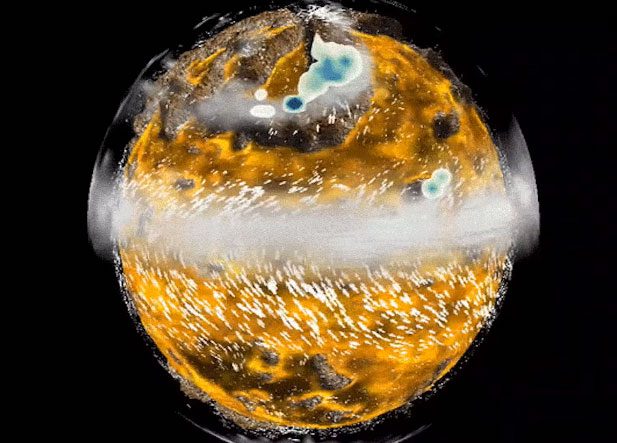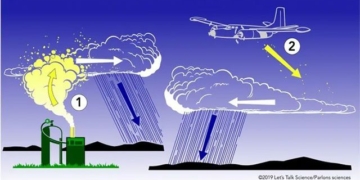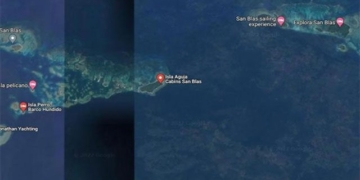The desert planet Arrakis in the novel Dune is too harsh for human habitation. However, climate simulations suggest that humans could potentially survive in such an environment.
Author Frank Herbert first introduced Arrakis in his 1965 novel Dune. It is a planet covered in sand, devoid of rain, lakes, or oceans. The book has been adapted into a film directed by Denis Villeneuve, with the second part recently released.

Arrakis in Dune is a planet of sand, without rain. (Photo: Warner Bros).
From details in the book, scientists have simulated and tested whether humans could survive on Arrakis.
What is the Climate of Arrakis Like?
“There are many factors that enable human life on Earth. The basic conditions include the atmosphere, the distance from the sun, and the availability of water,” said Amy J. Kreykes, a space medicine expert at the University of Texas.
A slight deviation in these factors could turn the environment hostile to humanity. The planet Arrakis in Dune is home to gigantic sandworms, a spice that allows interstellar travel, and two moons. However, it is not entirely different from Earth.

The planet Arrakis in climate simulation. (Photo: Conversation).
When the first part of Dune premiered in 2021, meteorologist Alexander Farnsworth, working at the University of Bristol, along with several other experts, simulated the environment of the planet depicted in the film. They incorporated everything described in the Dune Encyclopedia, including geographical characteristics, atmosphere, and astronomy.
Some aspects have been adjusted by the scientists, such as the weather differences at the poles and near the equator of Arrakis. Overall, Farnsworth expressed his admiration for the detailed world created by Frank Herbert. “What surprised me most was the accuracy with which the author envisioned a desert world without the aid of supercomputers or simulators,” he said.
Based on the team’s calculations, Farnsworth believes that humans could indeed live on Arrakis, although it would not be comfortable.
Challenges to Survival
The first issue of Arrakis is the lack of water. According to Rule Number 3, humans cannot survive more than 3 minutes without air, 3 days without water, and 3 weeks without food. To survive on a planet without seas, lakes, or streams, the Fremen must wear stillsuits. These suits can absorb sweat and bodily fluids to convert them into drinking water.
Such a solution is not entirely fanciful.
Seth Collins Hawkins, a wildlife medicine expert at Wake Forest University, argues that space is the most extreme environment lacking water. However, humans can still survive by recycling 85% of astronauts’ urine for drinking.

Stillsuits with advanced technology are essential gear for survival on Arrakis. (Photo: Warner Bros).
Temperature is also one of the adversaries for humans on Arrakis. “You can die from heatstroke before you run out of water,” Hawkins said.
Unlike in the book, Farnsworth’s climate model shows that the equator will provide a more temperate climate for humans. The hottest months in this region reach about 45 degrees Celsius. Extremely high temperatures occur at the poles, where summer can soar to 70 degrees Celsius, while winter can drop to -70 degrees Celsius.
Arrakis features climate distribution different from Earth, as the two polar regions have high atmospheric moisture, creating clouds and a greenhouse effect. The simulation software indicates that this planet still experiences some rainfall near the poles, contrary to the author’s description of a completely rainless world.
Humans should live around the equator of the sandy planet. They primarily operate at night when temperatures drop and seek shelter when the sun is active. “The scariest thing about being out there is heatstroke. The brain can be ‘cooked.’ Body temperature exceeds 41 degrees Celsius,” Hawkins noted.
Modern technology can greatly assist humans. Certain types of fabrics are both breathable and block thermal radiation. Small fans or air conditioning units would also be necessary in such conditions.
Frank Herbert’s description indicates that Arrakis has an atmosphere similar to Earth. It has nearly the same pressure, with less nitrogen and more oxygen. These conditions are sufficient for human habitation after a period of physiological adjustment. However, the differences could also lead to various health issues.
Overall, scientists believe that living in a place like Arrakis is entirely possible, though not comfortable. Technology would make this easier with solutions for water filtration and heat management.




















































